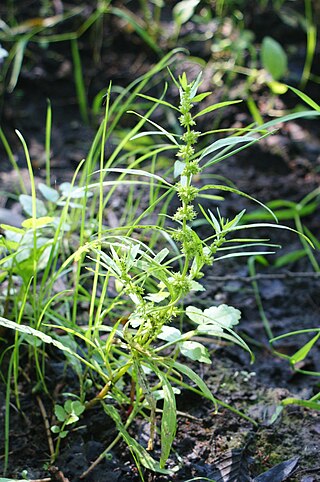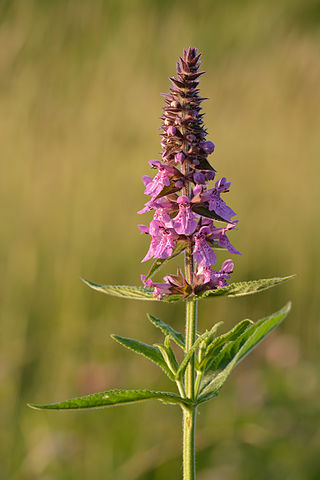
Urtica dioica, often known as common nettle, burn nettle, stinging nettle or nettle leaf, or just a nettle or stinger, is a herbaceous perennial flowering plant in the family Urticaceae. Originally native to Europe, much of temperate Asia and western North Africa, it is now found worldwide. The species is divided into six subspecies, five of which have many hollow stinging hairs called trichomes on the leaves and stems, which act like hypodermic needles, injecting histamine and other chemicals that produce a stinging sensation upon contact.

Phytoremediation technologies use living plants to clean up soil, air and water contaminated with hazardous contaminants. It is defined as "the use of green plants and the associated microorganisms, along with proper soil amendments and agronomic techniques to either contain, remove or render toxic environmental contaminants harmless". The term is an amalgam of the Greek phyto (plant) and Latin remedium. Although attractive for its cost, phytoremediation has not been demonstrated to redress any significant environmental challenge to the extent that contaminated space has been reclaimed.

Juncus effusus is a perennial herbaceous flowering plant species in the rush family Juncaceae, with the common names common rush or soft rush. In North America, the common name soft rush also refers to Juncus interior.

Mycoremediation is a form of bioremediation in which fungi-based remediation methods are used to decontaminate the environment. Fungi have been proven to be a cheap, effective and environmentally sound way for removing a wide array of contaminants from damaged environments or wastewater. These contaminants include heavy metals, organic pollutants, textile dyes, leather tanning chemicals and wastewater, petroleum fuels, polycyclic aromatic hydrocarbons, pharmaceuticals and personal care products, pesticides and herbicides in land, fresh water, and marine environments.

Scheuchzeria palustris, is a flowering plant in the family Scheuchzeriaceae, in which there is only one species and Scheuchzeria is the only genus. In the APG II system it is placed in the order Alismatales of the monocots.

Teucrium chamaedrys, the wall germander, is a species of plant native to the Mediterranean regions of Europe and North Africa, and the Middle East as far as Iran. It is used as an ornamental.

Rumex palustris, or marsh dock, is a plant species of the genus Rumex, found in Europe. The species is a dicot belonging to the family Polygonaceae. The species epithet palustris is Latin for "of the marsh" which indicates its common habitat.

Stachys palustris, commonly known as marsh woundwort, marsh betony, clown's woundwort, clown's heal-all, marsh hedgenettle, or hedge-nettle, is an edible perennial grassland herb growing to 80 centimeters tall. It is native to parts of Eurasia but has been introduced to North America. The species epithet palustris is Latin for "of the marsh" and indicates its common habitat.

Thelypteris is a genus of ferns in the subfamily Thelypteridoideae, family Thelypteridaceae, order Polypodiales. Two radically different circumscriptions of the genus are in use as of January 2020. In the Pteridophyte Phylogeny Group classification of 2016, the genus is a very small one with about two species. In other approaches, the genus is the only one in the subfamily Thelypteridoideae, and so includes between 875 and 1083 species.

Lemna minor, the common duckweed or lesser duckweed, is a species of aquatic freshwater plant in the subfamily Lemnoideae of the arum family Araceae. L. minor is used as animal fodder, bioremediator, for wastewater nutrient recovery, and other applications.

Rosa palustris, the swamp rose, is a shrub in the rose family native to much of eastern North America. It can be found from Nova Scotia and New Brunswick in the north, south to Florida and west to Arkansas and Ontario. It is a host of the blinded sphinx moth and Coptotriche admirabilis.

Pteris vittata, the Chinese brake, Chinese ladder brake, or simply ladder brake, is a fern species in the Pteridoideae subfamily of the Pteridaceae. It is indigenous to Asia, southern Europe, tropical Africa, and Australia. The type specimen was collected in China by Pehr Osbeck.

Eleocharis palustris, the common spike-rush, creeping spike-rush or marsh spike-rush, is a species of mat-forming perennial flowering plants in the sedge family Cyperaceae. It grows in wetlands in Europe, North Africa, northern and central Asia and North America. Eleocharis palustris is not easily distinguished from other closely related species and is extremely variable worldwide itself. The species epithet palustris is Latin for "of the marsh" and indicates its common habitat.

Spirodela polyrhiza is a species of duckweed known by the common names common duckmeat, greater duckweed, great duckmeat, common duckweed, and duckmeat. It can be found nearly worldwide in many types of freshwater habitat.

Pteris ensiformis, the slender brake, silver lace fern, sword brake fern, or slender brake fern, is a plant species of the genus Pteris in the family Pteridaceae. It is found in Asia and the Pacific.

Poa paludigena is a species of grass known by the common names bog bluegrass, marsh bluegrass, slender marsh bluegrass, and Patterson's bluegrass. It is native to the northeastern United States.
Athyrium yokoscense, commonly known as Asian common ladyfern in English and as Hebino-negoza in Japanese, is a species of fern in the family Athyriaceae. These tough plants live primarily in and around mine sites and thrive in soils contaminated with high concentrations of heavy metals, such as zinc, cadmium, lead, and copper. A. yokoscense is indigenous to Japan, Korea, eastern Siberia and northeastern China and has been known for centuries to tolerate phytotoxic mining sites. The predominance and concentration of this fern species at a particular region was used to identify potential mining sites. The primary potential of A. yokoscense is in its phytoremediative ability to accumulate toxic metals from soils contaminated with heavy metals, so it may have some long-term commercial importance. No medicinal or culinary values of this fern species have been studied or confirmed.

Ranunculus trichophyllus, the threadleaf crowfoot, or thread-leaved water-crowfoot, is a plant species in the genus Ranunculus, native to Europe, Asia and North America.

Coryphopteris simulata, synonym Thelypteris simulata, is a species of fern native to the Northeastern United States. It is known by two common names: bog-fern and Massachusetts fern. It is often confused with the silvery spleenwort, New York fern, and the marsh fern due to similarities in shape and size.




















